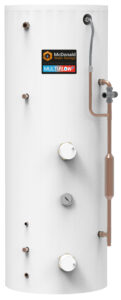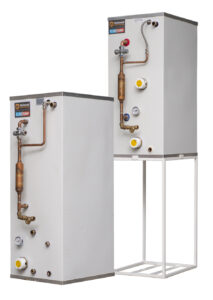Things You Should Know About Thermal Stores
Thermal storage is ideal for combining heat sources to maximise energy efficiency while providing water and space heating. Here are five thermal storage facts that installers should be aware of.
1) A Thermal Store Operates At Mains Pressure
A thermal store is a container that holds and regulates heat until it is required. It differs from a standard hot water cylinder in that the thermal store’s stored water is not delivered immediately to the taps. Heat is transferred from the thermal storage water to the mains or tap water by passing it through a plate heat exchanger. Heat exchangers, particularly flat-plate heat exchangers, may rapidly convey a considerable quantity of heat, allowing householders to take a mains pressure shower or quickly fill a bath.
Thermal storage may have one or more heat exchangers inside coiled pipes or outside flat-plate heat exchangers. A heating element, such as a standard immersion heater, may also be inserted.
Thermal storage can provide room heating and mains pressure hot water, or only hot water.
2) A thermal store can use a variety of fuels.
Thermal stores are built and sized to accept heat from various sources. It might be used to store heat from a wood-fired boiler, a solar thermal system, or a conventional gas or oil boiler. It must be specified when purchasing whether the homeowner intends to add a fuel source in the future.
A solid fuel device burns fuels including wood, wood pellets, and biomass (popular biomass fuels include discarded wheat, straw, nut shells, and other fibrous material). These fuels are frequently poorly quality, inherently unpredictable, and readily available. A thermal storage unit regulates the time lag between when heat is available and when it is needed for conversion into hot water and water heating.
Open vented thermal stores offer the ease and luxury of a pressure system with heat generated by solid fuel appliances and a straightforward and fundamentally safe method of providing high-performance mains pressure hot water.
The energy from the solid fuel appliance passes into the thermal store, supplying water circulating throughout the heating system. This means that the available energy might power the heating circuit, decreasing dependency on fossil-fuel-based boilers and lowering home operating costs.
Connecting wood-burning stoves or other uncontrolled heat sources to an unvented cylinder is impossible. Combining other energy heat sources to provide energy to the heating circuit is challenging, which is one of the distinct advantages of thermal storage.
Solar thermal energy can also be used to heat water through thermal storage. The thermal store uses a high-efficiency solar coil to give the homeowner natural solar energy produced during the day. When solar energy is insufficient to heat the store, it will convert to a conventional boiler as its primary heat source.
Although a sealed system boiler can directly supply the central heating circuit, an additional heating circuit can be coupled from the thermal store. The solar will also provide input.
3) When fuel sources are merged, the full potential of a thermal store is realised.
The full potential of a thermal store is realised when it uses a range of heat inputs.
A high-efficiency solar thermal input during the day could heat the water in the thermal storage.
Assume the property contains a wood burner, usually lit in the evening. In that instance, it might be coupled to a system that raises the water temperature in a thermal store created by solar energy during the day.
A regular boiler or an immersion heater could help with this.
Assume you have access to a low-carbon or renewable energy source. In such a situation, it might be linked to the immersion element to provide heat input to the thermal storage, reducing the demand for the fossil fuel boiler and, as a result, saving running expenses.
4) A thermal store is a fantastic off-grid option.
Off-grid residences with various heat sources, including wind power, are one example of where thermal storage can be a highly creative choice. When other energy sources were insufficient, the thermal storage would use mains electricity as a backup supply. Similarly, a thermal reserve can help reduce reliance on oil or LPG.
5) A thermal storage is simple to install and requires little upkeep.
Thermal storage can be installed practically everywhere in the home as long as the main header storage tank is installed above the radiators. They have no discharge pipes and require almost no maintenance, making them a perfect alternative for flats and retirement communities. Because there is no standing water, there is also no risk of Legionella or contamination.
The post Things you need to know about Thermal Stores for heating appeared first on https://gqcentral.co.uk












Comments are closed